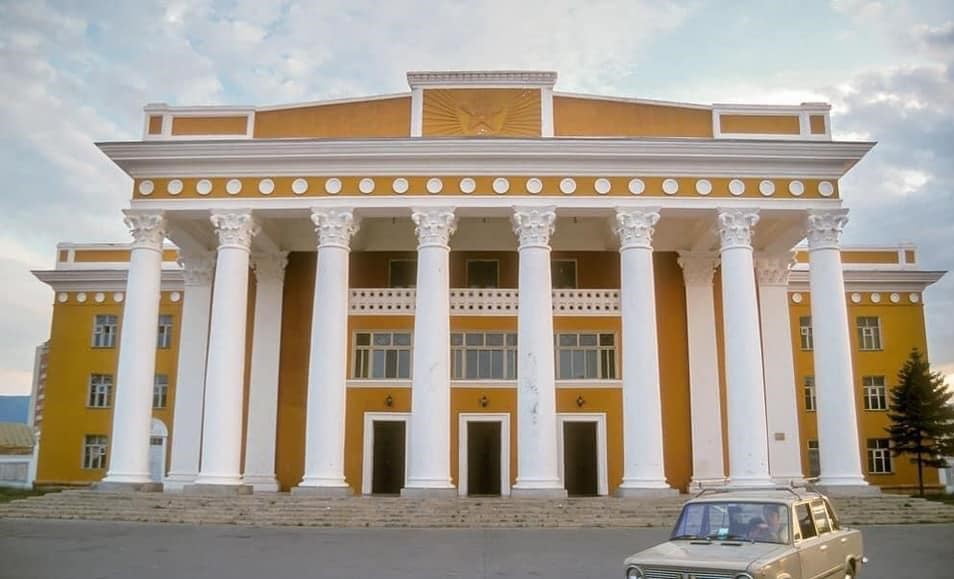Each country and city greets its guests through buildings and structures of certain architectural styles that are expressions of its history, culture and even a special event. Ulaanbaatar, too, has a number of historical monuments built in the process of Mongolia’s transition from its nomadic lifestyle to sedentary way.
Let’s check out some of Ulaanbaatar’s buildings which bring in the world’s classical architectural styles intertwined with the Mongolian heritage, which were a part of historical revival of classicism in architecture and which give us a sense of the society of their time.
Academic Opera and Ballet Theater
This is one of the masterpieces of neoclassicism in the modern Mongolian architecture. This building came to life during the “socialist content and national style” construction period so its ethnic features are visible. For example, there are statutes of a man holding a morin khuur (national musical instrument), a shepherd with a whip, a dancing maiden, and a statue of a Mongolian hero in the front. Placed above the entrance to the building, these four statues represent the Mongolians of that time. In addition, the interior of the theater is richly decorated with national ornaments giving impression of entering into a Mongolian fairy-tale setting. All this was created by the first modern Mongolian architects, sculptors and painters of that time. The Academic Theater of Opera and Ballet was originally built as the State Central Theater.
Drama Theater
This building was built by B.Chimed, one of the first modern professional architects of Mongola, in 1958-1960. True to the classic architectural design, the intellectual creation with over 2,500 years of history, this building has eight columns each of which is decorated with engraved horse heads and a mask which is a replica of the historical artifact found in Kharakhorum, the ancient capital city. These attributes allow to distinct this building from all other buildings of the classical style abroad. The unique combination of the Mongolian heritage, history and architectural features combining the western classicism with distinctly Mongolian style, make this building a valuable monument of the country’s modern city development.
National Central Library
The Cultural Heritage has registered is as “Architectural Monument” in 2015.
The design of the National Library building was designed by Russian architect K.P.Loginov and engineer N.Nikolaev in 1946-1947, it was built in 1948-1951 and commissioned on the 30th anniversary of the Mongolian People’s Revolution.
The style of a roof of this building resembles the general shape of the Mongolian traditional pavilion and is decorated with the Doric order columns, the simplest of the classical designs, adding to the grandeur of the ensemble. At the top of the main entrance of the Central Library, the coat of arms of the People’s Republic of Mongolia is placed on a khadag, a traditional ceremonial scarf, symbolizing the people’s sovereignty and reflecting the social trend of the time. The National Library building is a monumental building with a very unique interior design, majestic columns in the front, and represents the classicism in Mongolian architecture.
Built between 1946 and 1960, the above three classic and neoclassic style buildings signify the history of development of the national architectural styles. They are the first masterpieces of the most valuable architectural heritage of modern Mongolia.
The first cinema building
This is the first building specifically designated for cinema and was built according to the approved plan of renovation of the downtown of Ulaanbaatar. It was designed by engineer Klimov in 1945-1946, and commissioned on July 8, 1948. This is a 9,700-square-meter, three-story building with a cinema hall with more than 400 seats and a dance and exhibition hall on the ground floor. The Mongolian Stock Exchange has been located in this building since 1991.
Interestingly, in 1958, the Pobeda cinema was built under to this design in Ufa, former USSR.
Ministry of Foreign Affairs
In October 1947, the current building of the Ministry of Foreign Affairs (the central part) was commissioned. The most attractive part of the Ministry of Foreign Affairs building is its 44 exterior pillars. The golden-yellow decoration of these majestic tall columns, clearly representing the classic architectural canon of antiquity, is unique and fine. The Ionic style columns of this structure captivate with slender and ornate elegance, straight lines and spiral volutes calling for more feminine symbolism.





